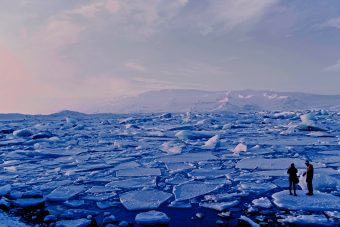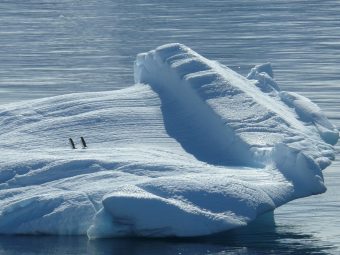
The recent collapse of a 1,100km2 ice shelf in Antarctica came at a time of record high temperatures and is a symptom of a planet in a climate crisis, experts say.
The Conger ice shelf, which cleaved away from the eastern side of Antarctica in March, is the latest victim of rising temperatures at the Earth’s poles. Experts say as the polar regions warm, more ice is likely to melt, potentially pushing up sea levels and inundating coastal communities.
“The current concentration of greenhouse gasses is higher than at any time in human history. It’s a very worrying signal,” said Pascal Peduzzi, Director of the Global Resource Information Database (GRID) – Geneva. GRID-Geneva is a partnership between the United Nations Environment Programme (UNEP), the Swiss Federal Office for the Environment and the University of Geneva.
The temperature at Vostok Weather Station in the central part of Antarctica in March normally averages -53°C. But between March 16 and March 20, around the time the ice shelf is believed to have collapsed, the temperature was on average 35°C warmer, hitting a balmy-for-Antarctica -18°C on March 17. The heat wave is part of a warming trend being recorded globally.
Satellite imagery, which dates back five decades, shows sea ice at both poles is in retreat. On February 21, 2022, Antarctic sea ice, which has until recently been stable, reached its minimum since measurements began in 1979.
The situation is much more dramatic at the opposite side of the planet. Forty years ago sea ice in the Arctic was typically three to four meters thick. Today, it is around 1.5 metres, according to a recent UNEP report, the Foresight Brief. Thinner ice and more open water lead to increased absorption of sunlight and increased melting in summer. Since 1979 around 50 percent of summer sea ice coverage has been lost.
“There has been a significant sea ice loss, especially in the last 20 years,” said Tore Furevik, a Director at the Nansen Environment and Remote Sensing Centre and a co-author of the Foresights Brief. “Sea ice loss indicates a climate that is getting warmer and warmer and is not in balance. The only way to stop this trend is to reduce emissions of greenhouse gases.”
More:
Melting sea ice leads to changes in the marine ecosystem, ocean circulation and weather events. In both the Arctic and Antarctica, warmer ocean water contributes to the melting of ice sheets. While Arctic melting doesn’t lead to a significant rise in sea levels, as the ice is already in the water, melting of Greenland or Antarctic ice will as it sits on land.
Key to curbing melting sea ice and ice sheets is mitigating climate change and keeping temperature rises in line with the Paris Agreement. As part of the pact, Member States committed to limiting global warming to well below 2°C, and preferably to 1.5°C, compared to pre-industrial levels. If the world meets its current climate-related pledges, the planet will still warm by at least 2.7°C, warns UNEP’s Emissions Gap Report by the end of the century, while the latest Intergovernmental Panel on Climate Change (IPCC) report indicates that the median global warming will be 3.2°C by 2100.

“We need to take the climate crisis more seriously,” said Peduzzi, “We have less than eight years to cut our emissions by half. This is not going to happen without a major reconfiguration of all the main sectors.”
UNEP has proposed what it calls a Six-Sector Solution to the climate crisis. It focuses on reducing greenhouse gas emissions in a half-dozen industries: energy, industry, agriculture and food, forests and land use, transport, buildings and cities. The report outlines how these six sectors can deliver more than 30Gt of emissions reductions and help to keep temperature rise in line with the Paris Agreement.
The United Nations has also released the ActNow campaign, which guides people on the individual choices they can make to limit global warming and reduce climate change.
In March 2022, UNEP launched an updated version of its data, information and knowledge platform called the World Environment Situation Room. There is a dedicated module on climate change, which includes daily updated graphs on the extent of Arctic and Antarctic sea ice. The webpage also highlights temperature anomalies and has a vast amount of data explaining and monitoring climate change.
This month, UN Secretary-General António Guterres said “that we are on a fast track to climate disaster.”
Peduzzi finds there is apathy around climate change as often people don’t realize the massive impact that each degree of warming can have on the planet. He said: “At 1.5°C, sea level rise is contained to 48 cm. At 3°C, sea level would rise by seven metres and marine ecosystems may collapse. At 4°C experts don’t see how adaptation would be possible.”
Source: UNEP



